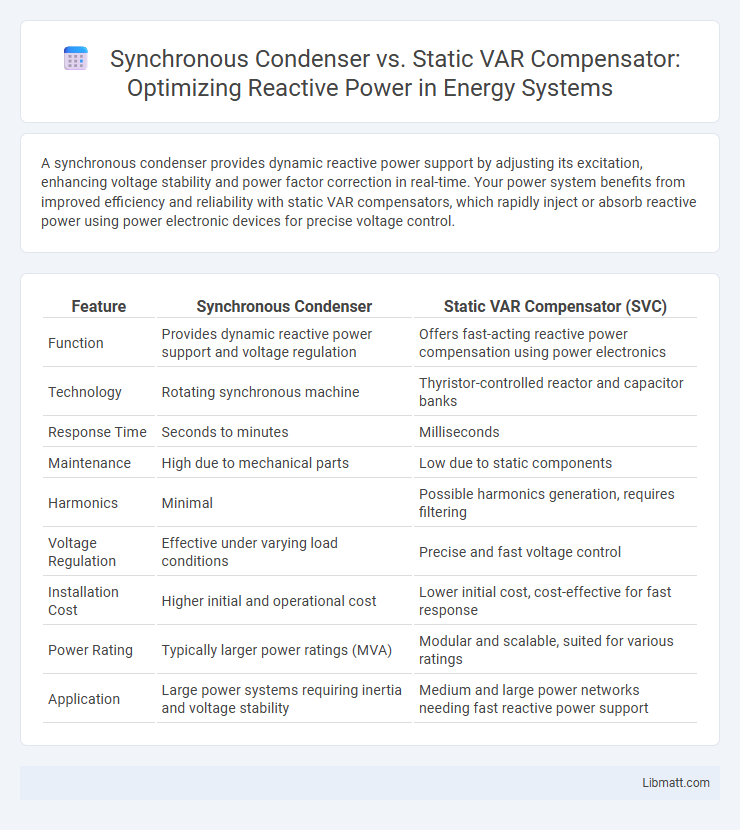A synchronous condenser provides dynamic reactive power support by adjusting its excitation, enhancing voltage stability and power factor correction in real-time. Your power system benefits from improved efficiency and reliability with static VAR compensators, which rapidly inject or absorb reactive power using power electronic devices for precise voltage control.
Table of Comparison
| Feature | Synchronous Condenser | Static VAR Compensator (SVC) |
|---|---|---|
| Function | Provides dynamic reactive power support and voltage regulation | Offers fast-acting reactive power compensation using power electronics |
| Technology | Rotating synchronous machine | Thyristor-controlled reactor and capacitor banks |
| Response Time | Seconds to minutes | Milliseconds |
| Maintenance | High due to mechanical parts | Low due to static components |
| Harmonics | Minimal | Possible harmonics generation, requires filtering |
| Voltage Regulation | Effective under varying load conditions | Precise and fast voltage control |
| Installation Cost | Higher initial and operational cost | Lower initial cost, cost-effective for fast response |
| Power Rating | Typically larger power ratings (MVA) | Modular and scalable, suited for various ratings |
| Application | Large power systems requiring inertia and voltage stability | Medium and large power networks needing fast reactive power support |
Overview of Synchronous Condenser and Static VAR Compensator
Synchronous condensers are rotating electrical machines that provide reactive power compensation and voltage support in power systems by adjusting their excitation. Static VAR compensators (SVC) utilize power electronic devices like thyristors to rapidly regulate reactive power and stabilize voltage without moving parts. Both technologies enhance grid stability, but synchronous condensers offer inertia and fault current contribution, whereas SVCs provide faster response and more precise reactive power control.
Working Principle of Synchronous Condenser
A synchronous condenser operates by adjusting its rotor speed to control reactive power flow and maintain voltage stability in power systems. By varying the excitation current of the synchronous machine, it can either absorb or supply reactive power, thereby regulating system voltage without transferring real power. This dynamic adjustment differentiates it from a Static VAR Compensator, which uses power electronic devices to rapidly provide reactive power support.
Working Principle of Static VAR Compensator
Static VAR Compensators (SVCs) regulate reactive power in electrical power systems by using power electronics like thyristors to rapidly switch capacitors and reactors, thus maintaining voltage stability and improving power quality. Unlike synchronous condensers that use rotating machines, SVCs provide fast-acting dynamic voltage control without mechanical inertia. Your grid benefits from SVCs' precise reactive power compensation, enhancing system reliability and efficiency.
Key Differences in Design and Operation
Synchronous condensers are rotating machines that generate or absorb reactive power by adjusting their excitation, providing inertia and voltage stability benefits. Static VAR compensators (SVCs) use power electronics such as thyristors to rapidly regulate reactive power through switching capacitors and reactors without moving parts. Your choice depends on system stability needs: synchronous condensers excel in dynamic voltage support and fault ride-through, while SVCs offer faster response and compact design for voltage regulation.
Applications in Power Systems
Synchronous condensers provide dynamic reactive power support and voltage regulation in power systems, making them ideal for stabilizing grids with large rotating machinery or renewable integration. Static VAR compensators (SVCs) offer fast-acting reactive power compensation and voltage control, commonly used in transmission systems to improve power quality and reduce voltage fluctuations. Your choice depends on factors like system inertia requirements, response speed, and installation complexity in applications such as grid stabilization, voltage support, and power factor correction.
Advantages of Synchronous Condensers
Synchronous condensers provide superior voltage stability and reactive power support in power systems compared to Static VAR compensators, enabling more effective grid regulation during load variations. They offer continuous and adjustable reactive power output, which enhances system reliability and reduces the risk of voltage collapse. Your power network benefits from their ability to improve power factor correction and provide inertia, aiding in frequency stability and system resilience.
Advantages of Static VAR Compensators
Static VAR Compensators (SVCs) provide rapid dynamic voltage support and improve power system stability by continuously regulating reactive power. Their solid-state design offers lower maintenance requirements and faster response times compared to rotating synchronous condensers. SVCs excel in mitigating voltage fluctuations and enhancing power quality in high-voltage transmission networks, making them ideal for modern grid applications.
Limitations and Challenges of Each Technology
Synchronous condensers face limitations such as high installation and maintenance costs, bulky size, and slower dynamic response compared to power electronic-based devices. Static VAR compensators (SVCs) encounter challenges including harmonic generation, limited overload capacity, and dependency on fast-acting power electronics that may suffer from reliability concerns under extreme conditions. Both technologies must address grid integration complexities and coordination with other reactive power compensation devices to maintain voltage stability effectively.
Cost and Maintenance Considerations
Synchronous condensers typically involve higher upfront costs and more complex maintenance due to their rotating machinery and mechanical parts, requiring regular inspections and lubrication. Static VAR compensators (SVCs) offer lower initial costs and reduced maintenance needs, as they use solid-state components with fewer moving parts, leading to increased reliability and decreased downtime. Your choice depends on balancing the long-term operational expenses and capital investment, with SVCs often favored for lower maintenance budgets.
Choosing the Right Solution for Reactive Power Compensation
Selecting between a synchronous condenser and a static VAR compensator (SVC) depends on system requirements such as response time, voltage stability, and harmonic performance. Synchronous condensers offer robust inertia and fault current support, making them suitable for large industrial grids requiring dynamic reactive power control. In contrast, SVCs provide faster response and superior harmonic filtering, ideal for applications demanding rapid voltage regulation and power quality improvements.
Synchronous condenser vs Static VAR compensator Infographic

 libmatt.com
libmatt.com